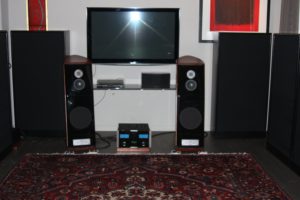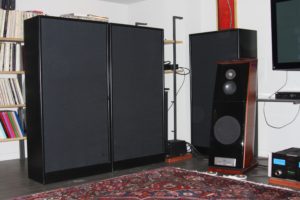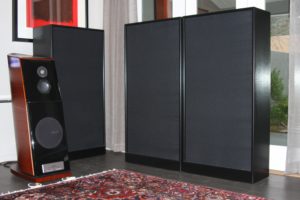Listening rooms in our homes are usually of two main types; multipurpose and dedicated. Listening rooms in a living room set up are multipurpose rooms. That means that in addition to the listening of recorded music, the room is used for other functions. Those that are fortunate to have a room that is just for music listening only, have a dedicated listening room. Finding good sound in a living room is always a balance between function and aesthetics. A dedicated room is concerned about good sound without all the emphasis on appearance.
Dedicated Listening Room
One can design a dedicated listening room that will compliment the type of music that the individual wishes to play in it. If one enjoys orchestral music, then we must look at how that source was recorded in order to compliment the recording in playback mode. Most orchestral recordings are done in large rooms with higher reverberation times. A reverberation time of 2 seconds is not uncommon. This 2 second reverberation time is present through the whole recording and must be planned for in our dedicated listening room if this is the music type we wish to realize the fullest sound from within our room.
Subjective Reverberation
Another music source in our room could be popular music which is usually recorded in dead rooms with little or no reverberation. Each track is individually laid down with as little room sound as possible. We have the rhythm section on one track, lead on another, and vocals on still another track. All tracks are then combined together in a mix down. Electronic manipulation is then applied to “sweeten” up the mix. Reverberation is a popular add on at this point. Our dedicated listening room must take reverberation into consideration in order to impact the listening position in the manner the recording engineer would “approve” of.
Room Resonant Chamber
Our listening room is really a resonant cavity. The room does not resonate but the air placed inside it through the use of our speakers does. Wavelengths of different lengths will either fit into our room or resonate cavity or will try and fit but will complain about it through resonance production. Below 300 Hz., wavelengths are long and can produce this resonance. Above 300 Hz.,they are shorter and fit better within the room. If we take a 300 Hz. wavelength, which is 3.8 ‘, one can see that this will fit easily within most rooms. A 100 Hz. wave at 11’ may not depending on room dimensions. It is how well they fit into the given room dimensions that will determine their behavior.
Dimensions And Volume
The size and volume of a room are critical if we are going to minimize resonances. There are ratios of length, width, and depth that must be considered that will reduce the amount of resonances and their corresponding strength. Room modes or room resonances need to be spaced apart and not coincident. By adapting certain height, width, and length dimensional ratios, one can figure out the best dimensions for your budget and space requirements. Bolt was an engineer who developed some of these ratios and if you choose a height, width, and length within the “Bolt Area”, you will have a good modal separation and distribution throughout the room size and area. Stay away from rooms that are less than 1,500 cu.ft.
Listening Tests Over Time
Since our example above with the orchestral music had a reverberation time of 2 sec., and this is the type of music we will be listening to in our listening room, we must be concerned with reverberation times. How long of a reverberation time do we want in our rooms. Obviously, it depends on the type of music we are listening to but other than that criteria, reverberation times are highly subjective. One does not want the room too dead but neither do we want it too live. Either one of those extremes produces listener fatigue. Only careful listening tests over extended time periods, will determine what is correct for your individual room.
Low Frequency Pressure Management
Low frequency issues within our listening rooms must be addressed. All listening rooms, other than those with 30′ dimensions, will need some degree of low frequency management. The space between the two end walls in a rectangular room will produce low frequency resonances along with the space between the two long walls. This is normally the area reserved for the listening chair and low frequency issues in the middle of the room will blur and smear the sound at the listening position. The corners of the room and all wall/ceiling and wall/floor intersections must be addressed. Make sure you consider diaphragmatic absorption for low frequency management. Pound for pound it is the most powerful of all low frequency absorption technologies.
Middle And High Frequencies
Middle and high frequencies do not cause as many resonances as longer low frequency wavelengths. The direct sound or the sound that travels in a straight line from the speaker to the listening position, strikes our ears first since it travels the shortest distance. Next, we have all the specular reflections which come from the ceiling, floor, side and rear walls. When the two meet, and these two energy time signatures arrive at our ears separated by millisecond intervals, our brains get confused. If the recording has a strong central image in the mix, our brains will perceive the center stage and image as moving more left or more right if direct and specular energy intermix improperly.
Choose Correct Technology
Middle and high frequency absorption can reduce the amplitude of ceiling, floor, side, and rear walls. Absorption technology must be chosen that has a smooth rate and level of absorption without taking too much of a bite out of the 125 Hz.- 250 Hz. region. This is the critical low middle frequency area where our vocals lie. This is scared ground and must be treated with respect which definitely includes no over or under absorption. A gradual and steady absorption curve is required. We are talking about slowing energy down that is only a few milliseconds away from being a non audible issue, but rate and level of absorption are critical.
Dedicated Choice
If one can choose between a listening room that is multifunctional and one that is dedicated to listening only; choose the dedicated room. We must pick the correct starting dimensions, so that resonances are spread out throughout the room and are not too strong in any one room part. There are ratios for width, length, and height that minimize resonances. Don’t forget to include extra space for low, middle, and high frequency, sound energy management and choose the correct acoustical technology. Choose the correct blend of technologies to create your own sonic room signature.








